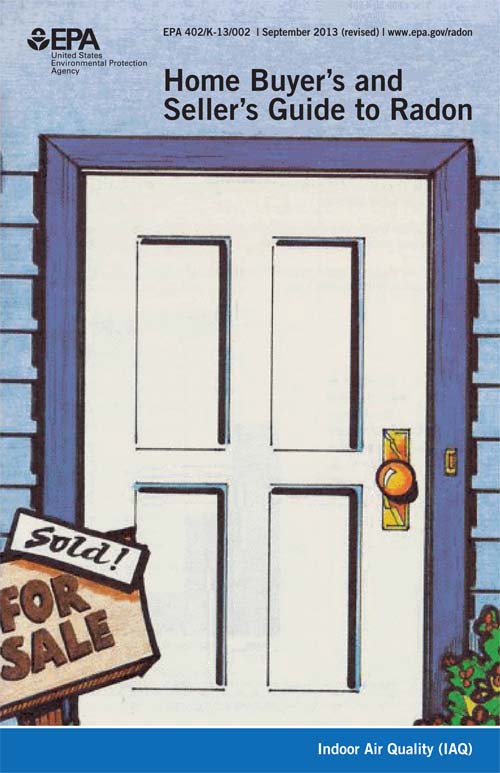Best Commercial Radon Inspection in Columbus Ohio
We proudly provide the best radon inspection in Columbus, Ohio! Whether you’ve owned your home or business for several years or you’re looking to purchase a new one, it’s important to protect your investment by thoroughly testing for potential hazards. While most property owners are aware of the importance of a general inspection, a radon inspection is often overlooked. In some cases, Ohio residents simply aren’t aware of the dangers and prevalence of radon in our state. In other cases, property owners don’t want to spend the extra time and money on a radon inspection.
Fortunately, Home & Commercial Inspections LLC is equipped to help Ohio and Columbus area residents quickly identify the presence of radon and take the necessary steps to ensure safety. Our licensed radon inspectors have the knowledge and experience to quickly conduct a thorough inspection. We offer the best in convenience, affordability, and unparalleled expertise so you can feel confident your home or business provides a safe and healthy environment for everyone.
What is Radon?
One of the main reasons property owners skip a radon inspection is because they simply aren’t aware of radon and the dangers it can pose. Radon is a radioactive gas that is both colorless and odorless, making it impossible to detect without specific tests. This gas forms when naturally occurring uranium decays. Typically, radon gas is found in the soil and seeps into structures through cracks in the foundation. Because radon is radioactive, it poses a variety of health problems to those who are exposed to high levels for prolonged periods. In fact, radon is the number-one cause of lung cancer among nonsmokers.
Is There a Safe Level of Radon
The United States Environmental Protection Agency (USEPA) has determined that a measurement of less than 4 picocuries per liter of air is a safe level. Once the concentration of radon reaches 4.0 pCi/L or above, the USEPA recommends that property owners take action to reduce the amount of radon and protect their health.
When inhaled or absorbed in small quantities (less than 4.0 pCi/L), radon is not considered a health threat. If testing reveals levels above the norm, further analysis is necessary. Both odorless and colorless, it is impossible to detect without special equipment, and prolonged exposure can lead to lung cancer.
Where Does Radon Come From
Radon gas is created during the natural breakdown of uranium in the ground. Uranium is a natural element with weak radioactivity in its original state. However, when the material starts to decay, it changes from a solid form to a gas form, and this is when it becomes dangerous to humans. Typically, radon is found in soil and rocks, but it can also be present in rivers, lakes, and well water. Radon exposure occurs when humans inhale the gas, but radon can also be ingested. Because it originates from the soil, lower levels of the property, including the basement, will have the highest levels of radon.
Have Questions About a Radon Inspection in Columbus Ohio?
Fill out the form below and we will give you a prompt reply.
"*" indicates required fields
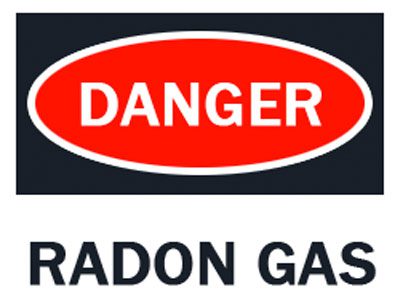
For the safety of your home and family, contact us and schedule a radon inspection in Columbus Ohio.
How Does Radon Affect the Body
Radon is most associated with lung cancer. When inhaled, the particles attack the lungs, ultimately resulting in abnormal cells that multiply and form cancerous tumors in the lungs. The USEPA estimates that 21,000 people per year die of lung cancer caused by radon exposure. Among nonsmokers, it is the number-one cause of lung cancer.
Call us today and schedule a radon inspection for your Columbus, OH, home.
RADON RISK IF YOU HAVE NEVER SMOKED

Note: If you are a former smoker, your risk may be higher.
*Lifetime risk of lung cancer deaths from EPA Assessment of Risks from Radon in Homes (EPA 402-R-03-003).
**Comparison data calculated using the Centers for Disease Control and Prevention’s 1999-2001 National Center for Injury Prevention and Control Reports.
EPA 402/K-13/002 | September 2013 (revised)
How Does Radon Affect Smokers
Smokers who are exposed to radon have a significantly higher risk of developing lung cancer. Years of smoking can damage the protective membranes that cover the lungs. Without the help of these membranes, the lungs are left more vulnerable to the harmful cancer-causing effects of radon. The statistics regarding exposure to high levels of radon, smoking, and lung cancer are frightening:
Call us today and schedule a radon inspection for your Columbus, OH, home.
RADON RISK IF YOU SMOKE
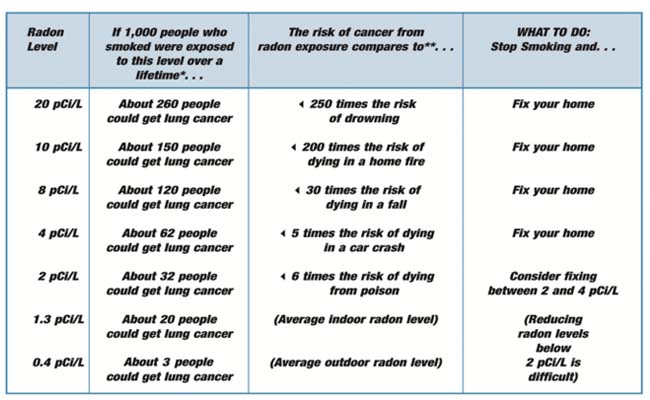
Note: If you are a former smoker, your risk may be lower.
EPA 402/K-13/002 | September 2013 (revised)
How Does Radon Enter My Home
Radon enters the home through cracks around the house and holes in the foundation. As uranium, which naturally occurs in the soil, decays, it turns into radium and gives off radon gas. This odorless and colorless gas can easily seep through tiny cracks.
In addition, decaying matter can also attach to building materials, which means that low levels may be detected in drywall, granite countertops, and other areas of the home. Getting your foundation and crawl spaces inspected is part of the prevention process, but the only way to ensure your home or business is safe is to have the property specifically tested for radon.
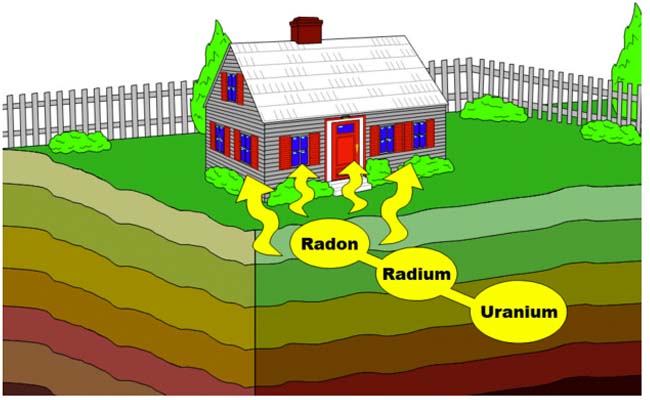
Schedule your radon inspection in Columbus Ohio now: 1-800-241-1033
How Do I Test for Radon?
While homeowners do have the option of purchasing DIY radon testing kits, the best option is to hire a highly trained and licensed expert to conduct the testing. A passive test kit might give you a general reading, but it is only a short-term solution. If high levels of radon are detected, you will have to invest in a professional inspection that will pinpoint the source of radon and make specific recommendations for reducing your exposure, ensuring radon gas remains at a safe level.
What Does a Radon Inspection Involve?
The good news is that conducting a professional radon inspection is relatively easy. A licensed inspector will use active devices that require power to function and continually monitor radon levels. These devices will be placed in the lowest level of the home that is used regularly. For the best results, the testing device should be set up in an open area. Placing it in a closet or other enclosed space may produce inaccurate results. Using active electronic devices will not only prevent but also detect test interference so inspectors can accurately read the results. Electronic testing devices are also useful because they will report any abnormalities or swings in radon levels, which can be caused by seasonal changes and other factors.
How Long Does a Radon Test Take?
At an absolute minimum, a radon-detecting device should be placed in the home for a full 48 hours. However, 90 days is still considered a short-term test. Often, a long-term test of over 90 days is used to confirm short-term test results and produce a report that includes seasonal variations. Property buyers may not have the luxury of waiting over 90 days for a radon test. In this case, any reading of 4 pCi/L or over should result in repairs being made to the home.
How Can I Lower Radon Levels in My Property?
The easiest way to lower radon levels is to seal any cracks and openings in the foundation. While this may prevent some radon gas from entering the home, the best way to significantly reduce levels and implement a long-term solution is to install what is known as a sub-slab depressurization system. These systems use a combination of vents and fans to direct radon gas away from the home. While the exact configuration of each system will vary according to the individual home and its specific challenges, you will never have to worry about making major changes or renovations to your home. Any system can be easily installed.
What Areas in Columbus Are Radon Levels the Highest?
The prevalence of high radon levels varies across the state of Ohio. As you can see from EPA Map of Radon Zones, much of the northern half of Ohio is labeled as Zone 2, which means that the EPA predicts indoor levels of radon gas to reach or exceed 4 pCi/L, which is the level they recommend taking action. Many of the southern counties and areas of the northwest are listed as Zone 3 areas, which have a low potential for radon gas.
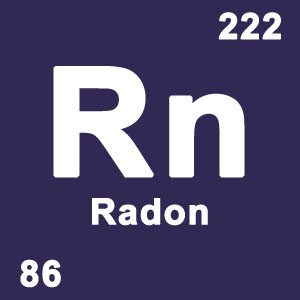
Radon is a “noble gas,” but there's nothing noble about it being in your home! Schedule your radon inspection in Columbus, Ohio, today
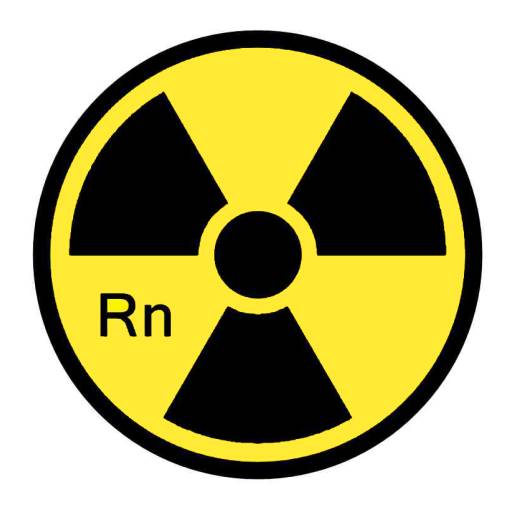
Radon is hazardous to your health. Contact us for a thorough radon inspection in Columbus, OH.
Which Ohio Counties Have the Highest Concentration of Radon Gas?
As you can see from the map, many of Ohio’s centrally located counties are predicted to have the highest levels of radon gas concentration. This estimate is based on prior testing and environmental factors that produce radon. While the areas marked in orange and yellow will generally have lower levels of radon gas, residents and property owners in these areas should still have their residential and commercial buildings tested and demand an inspection before purchasing.
Why Is Ohio at a High Risk for Radon Gas?
The state of Ohio is home to two unique geological formations that make its residents at an especially high risk of exposure to radon gas. Much of the state is covered in a shale outcropping. This special type of sedimentary rock contains organic materials that naturally break down and produce radon. In addition, Ohio was formed by glaciers that deposited sediment that is also known to be high in radon. Combined, these two factors create a perfect storm for producing high levels of radon gas in Ohio homes and businesses.
Rely on Home & Commercial Inspections LLC for Radon Inspection Services
Having your home or business thoroughly inspected for radon gas is an important step in protecting your family, friends, and co-workers. A simple and inexpensive test can save lives. At Home & Commercial Inspections LLC, we have a team of licensed radon inspectors who are dedicated to protecting the health and well-being of Ohio residents. Our experts will conduct a thorough analysis of your building or home, present the findings in a way that is easy to understand, and make recommendations for how to improve your environment.
Contact us today to schedule your home or business radon analysis.
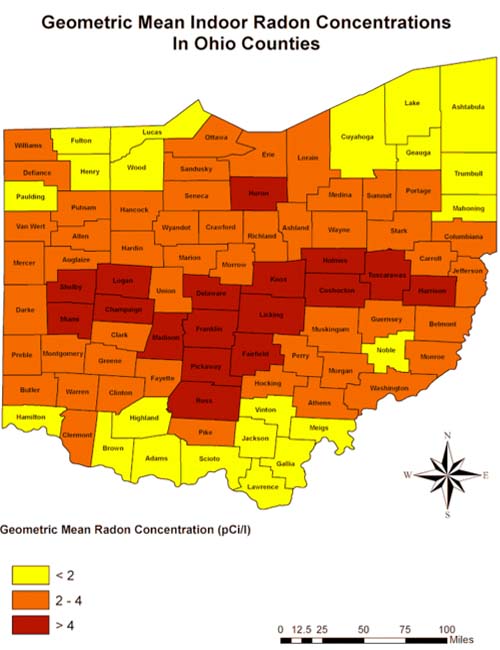
Radon in Schools
Children are especially susceptible to radon poisoning. At 4 pCi/L, a student's radon exposure is the same as smoking half a pack of cigarettes each day. In a school year, students exposed to 4 pCi/L will absorb around ten times the amount of radiation allowed outside a nuclear power plant!
Nationally, nearly one in five schools has at least one classroom with short-term radon levels above 4 pCi/L. EPA estimates that more than 70,000 schoolrooms have high short-term radon levels. At this level, the EPA recommends you take immediate mitigation measures.
Because professional testing is the only way to know whether your school has high radon levels, Home & Commercial Inspections LLC will perform a thorough radon inspection throughout the premises, ensuring the safety and well-being of students and staff.
Even if your school fails the radon test, the problem can be remedied. There are procedures that have been shown to reduce radon levels and the risk of lung cancer caused by radon exposure.
Testing is straightforward and affordable. After all, radon is a health concern that no one should have to deal with, whether at home or at school.

Radon in Multifamily Housing
Many people in the US live in attached townhouses or low-, mid-, or high-rise apartments and condos. These buildings pose unique challenges because pollutants may move from unit to unit, and residents may be unable to structurally change their building.
Radon is the second-leading cause of lung cancer. Because safe radon levels are unknown, the EPA recommends property owners take action when indoor levels are between 2 pCi/L and 4 pCi/L. Our inspection is the first step to ensuring safe air quality for all occupants.
Large foundations and complex HVAC and ventilation systems are common in multifamily dwellings. As experienced, certified contractors for radon testing and mitigation services in Columbus, Ohio, we provide the most thorough inspections to diagnose radon in your multifamily complex.
The U.S. Dept. of Housing & Urban Development (HUD) requires radon testing for mortgages for:
- Multifamily Accelerated Processing (MAP)
- Traditional Application Processing
- New construction or substantial rehabilitation of multifamily housing
- Purchase or refinance of existing multifamily rental housing
- Building or renovations of rental housing for the elderly or disabled
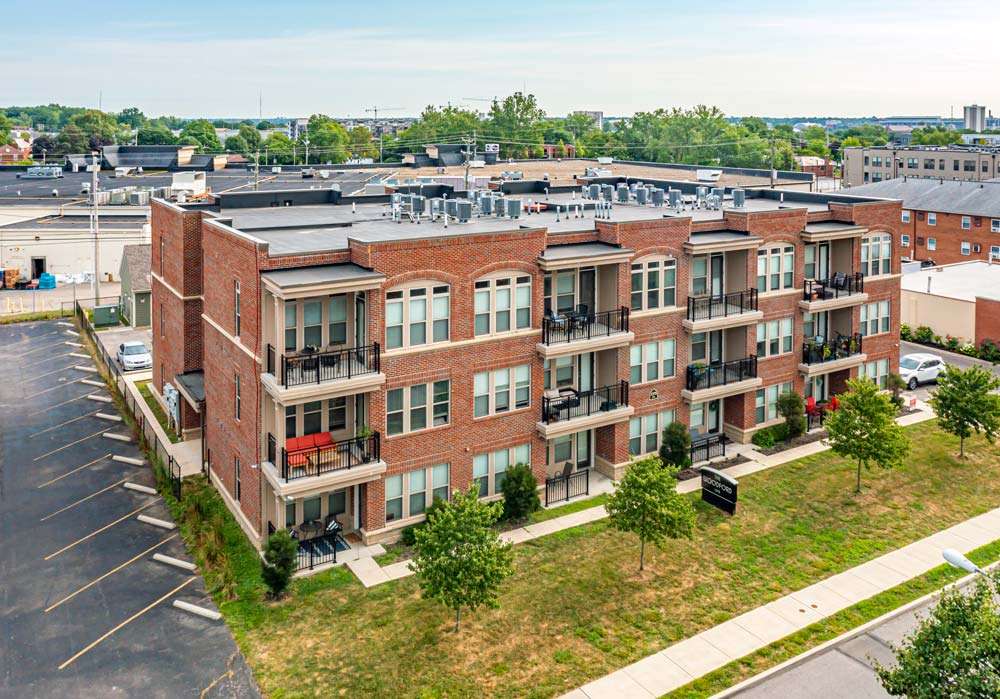
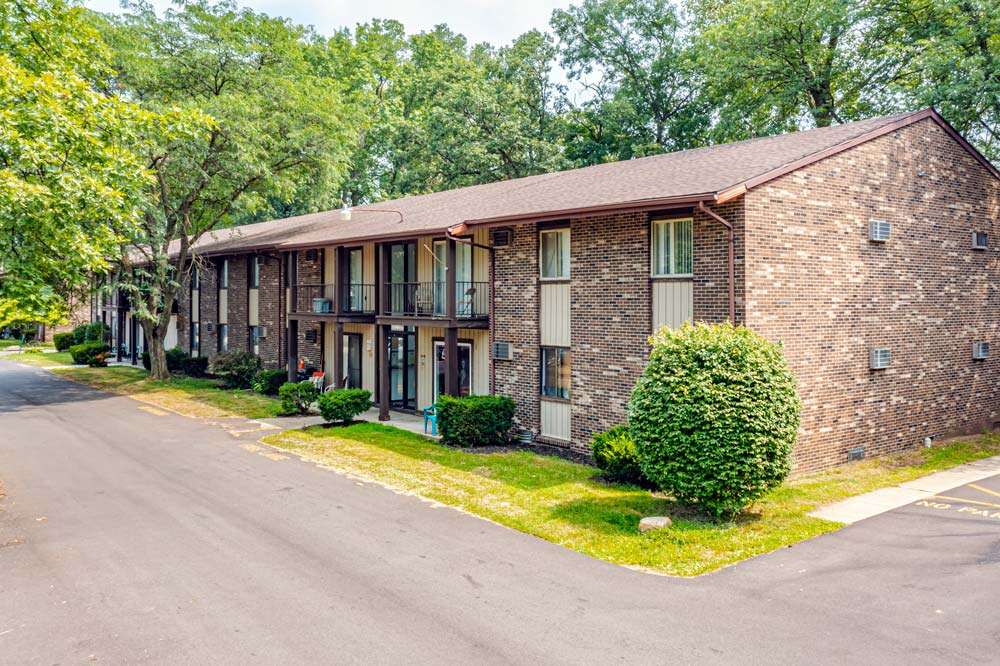
Radon in Commercial Buildings
The potential for radon in commercial buildings should never be overlooked. Employees can spend eight hours or more a day at their place of work, and if radon levels are high, they are at risk of developing lung cancer.
Employers must make sure their workplace is safe and healthy; this includes testing for radon gas. There is no EPA-specified radon action level for commercial properties; however, we recommend applying the residential standard of 4 pCi/L.
Commercial buildings can have unique requirements and characteristics, which must be accounted for in an inspection, such as stronger indoor air flow and distinctive structural characteristics and radon entrance sites.
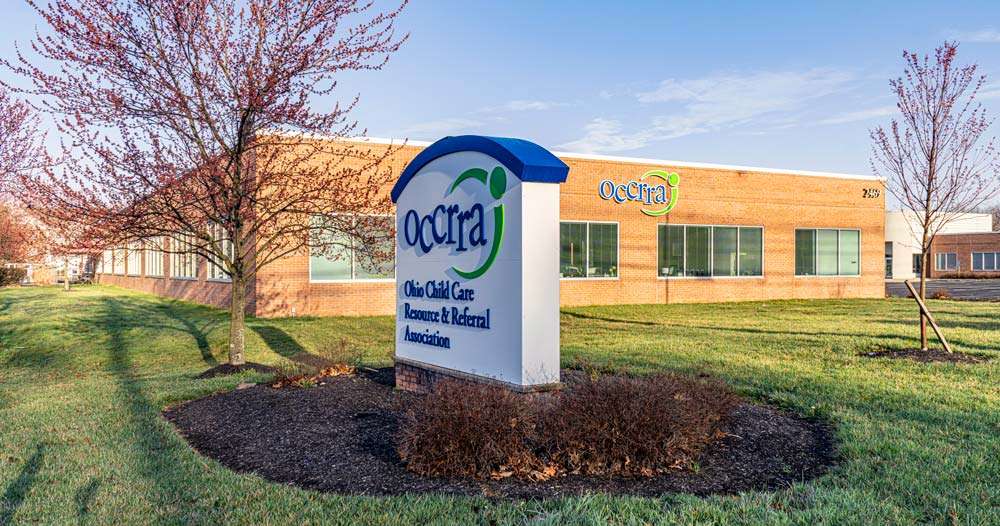
Columbus, Ohio Radon Inspections
Home Inspections LLC provides quality radon inspection service throughout Columbus, Ohio and surrounding areas.
Columbus, Ohio Radon Inspection Reviews
Check out our awesome radon inspection reviews! These are real people and real reviews!

